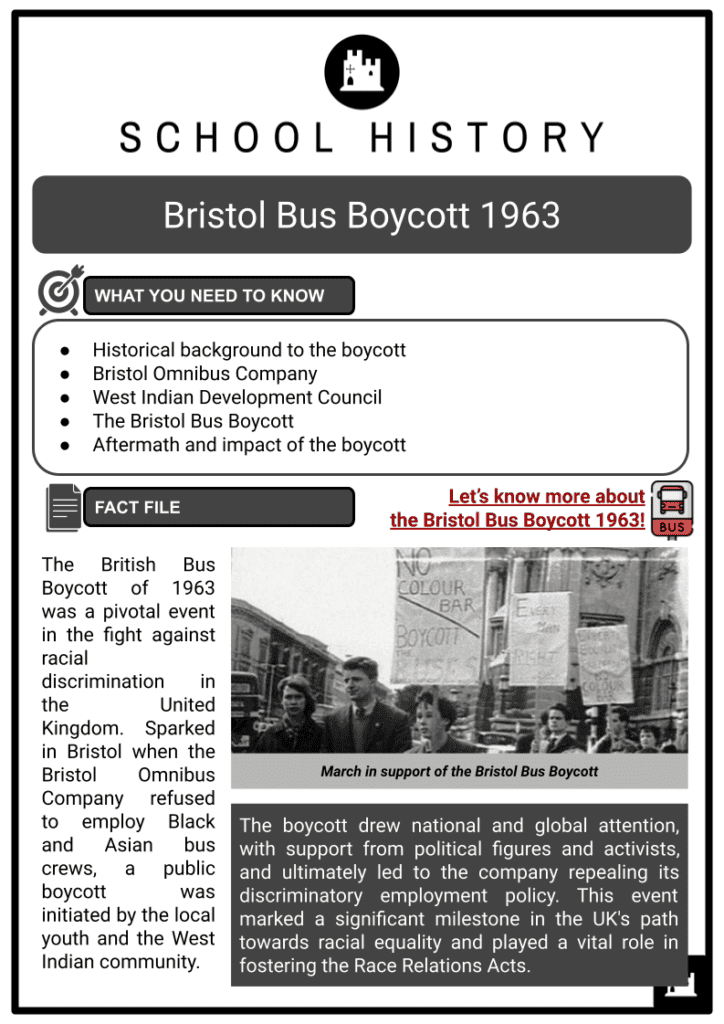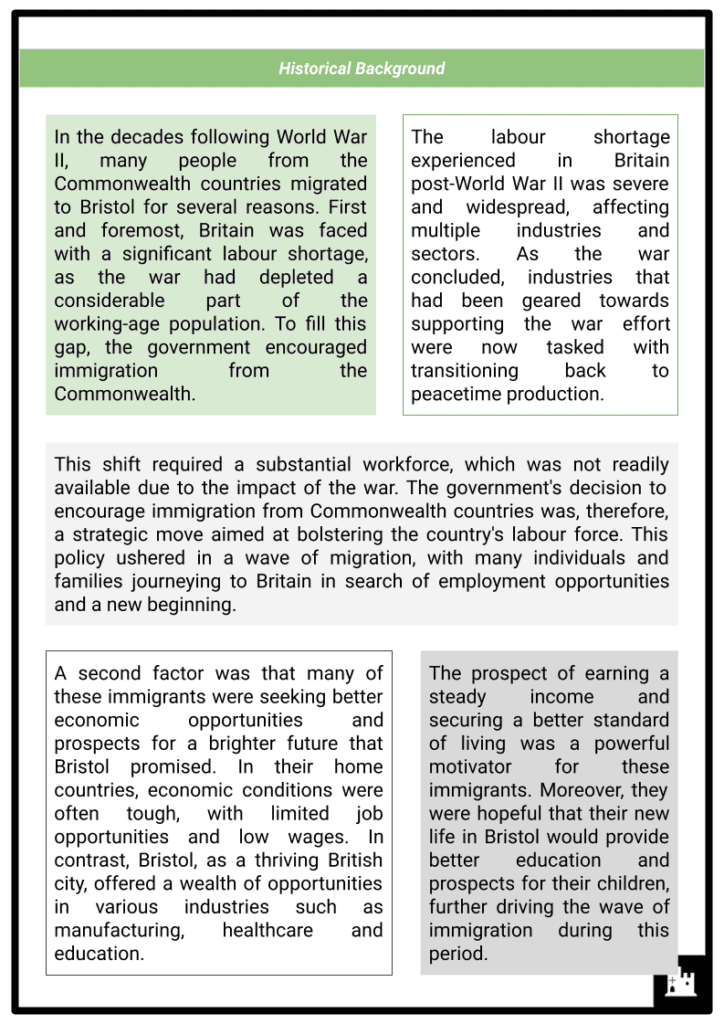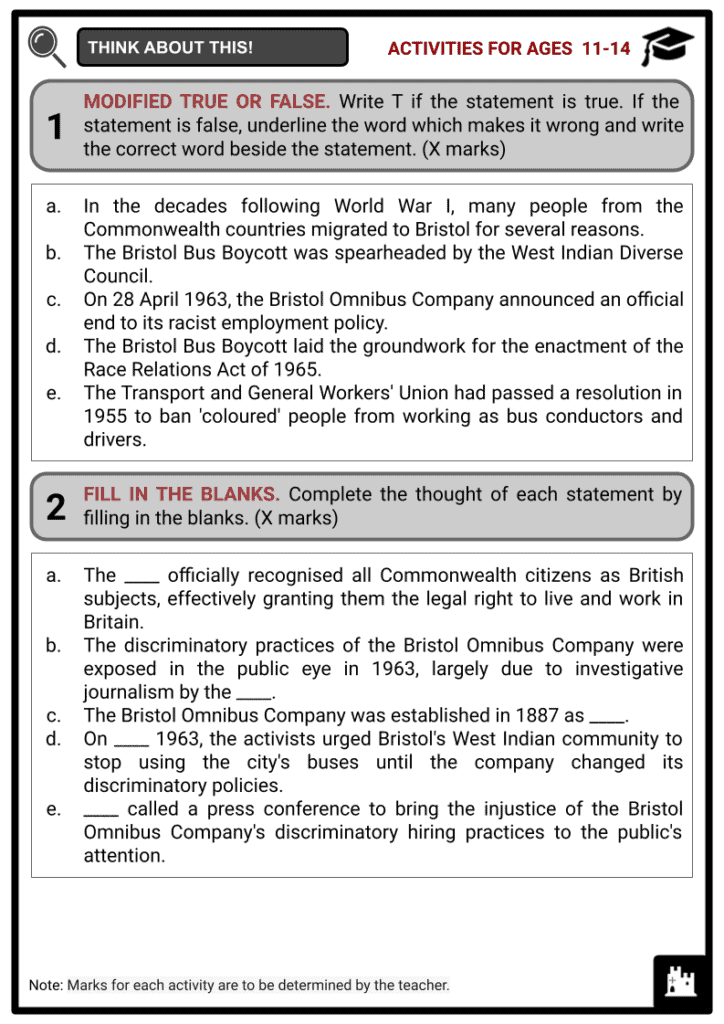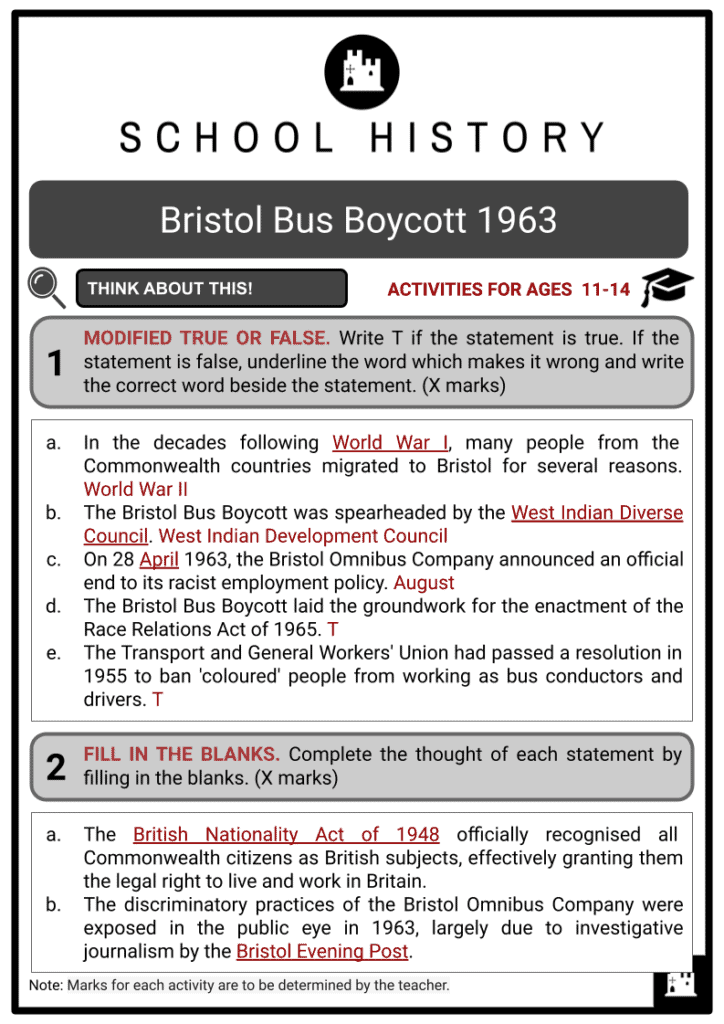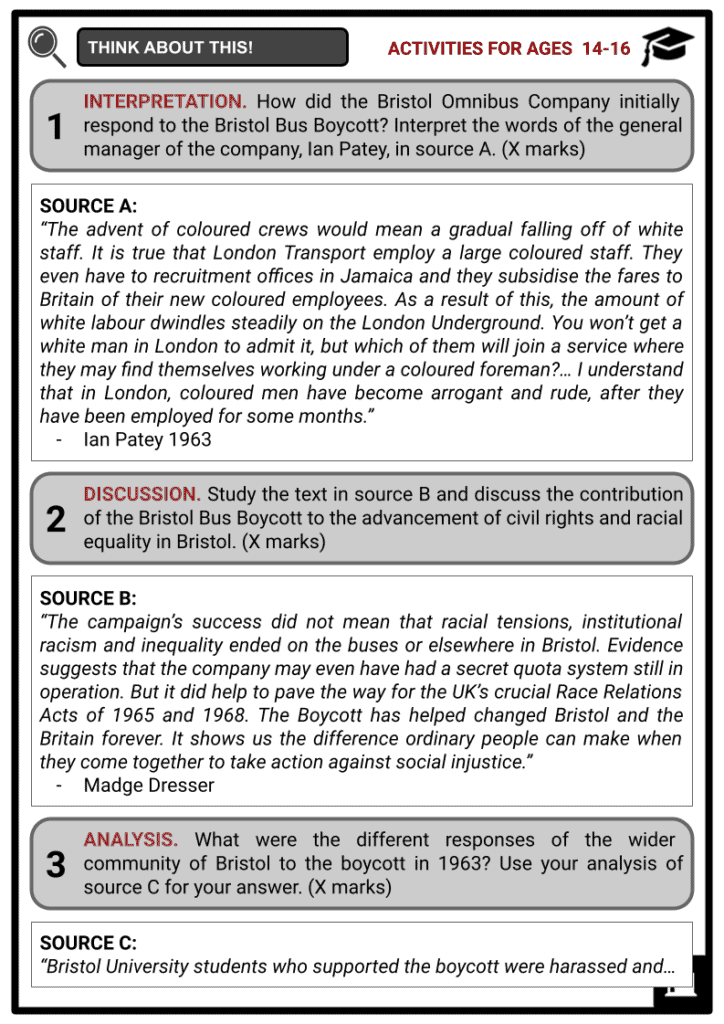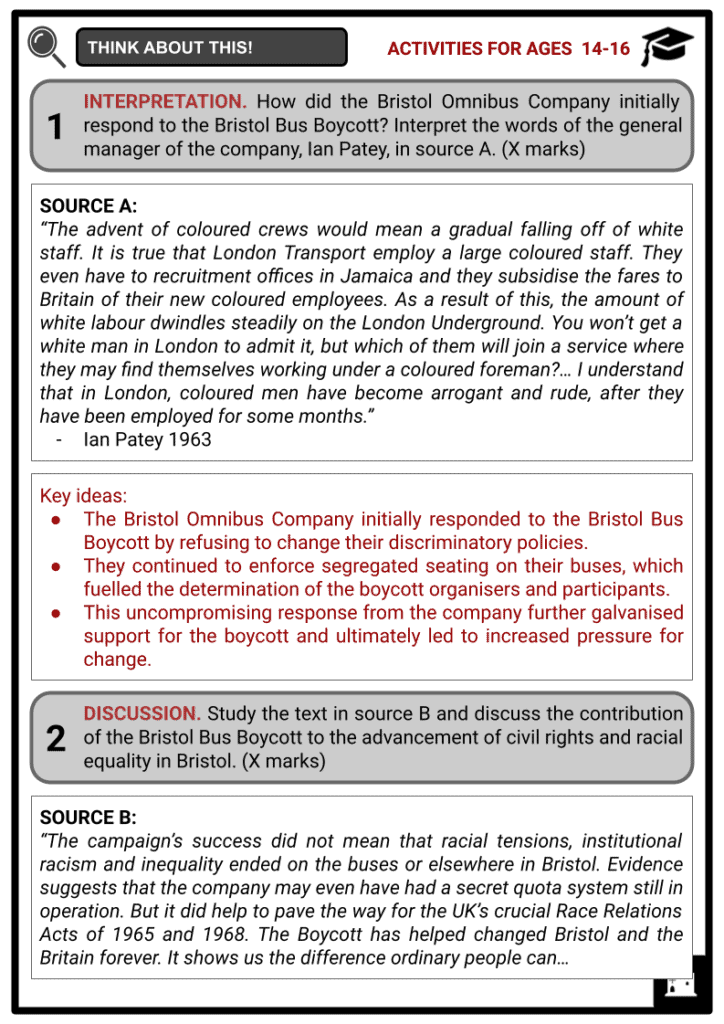Bristol Bus Boycott 1963 Worksheets
Do you want to save dozens of hours in time? Get your evenings and weekends back? Be able to teach about the Bristol Bus Boycott 1963 to your students?
Our worksheet bundle includes a fact file and printable worksheets and student activities. Perfect for both the classroom and homeschooling!
Summary
- Historical background to the boycott
- Bristol Omnibus Company
- West Indian Development Council
- The Bristol Bus Boycott
- Aftermath and impact of the boycott
Key Facts And Information
Let’s know more about the Bristol Bus Boycott 1963!
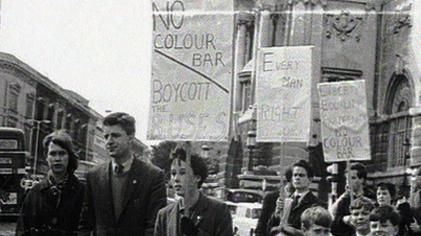
The British Bus Boycott of 1963 was a pivotal event in the fight against racial discrimination in the United Kingdom. Sparked in Bristol when the Bristol Omnibus Company refused to employ Black and Asian bus crews, a public boycott was initiated by the local youth and the West Indian community. The boycott drew national and global attention, with support from political figures and activists, and ultimately led to the company repealing its discriminatory employment policy. This event marked a significant milestone in the UK's path towards racial equality and played a vital role in fostering the Race Relations Acts.
Historical Background
- In the decades following World War II, many people from the Commonwealth countries migrated to Bristol for several reasons. First and foremost, Britain was faced with a significant labour shortage, as the war had depleted a considerable part of the working-age population. To fill this gap, the government encouraged immigration from the Commonwealth.
- The labour shortage experienced in Britain post-World War II was severe and widespread, affecting multiple industries and sectors. As the war concluded, industries that had been geared towards supporting the war effort were now tasked with transitioning back to peacetime production.
- This shift required a substantial workforce, which was not readily available due to the impact of the war. The government's decision to encourage immigration from Commonwealth countries was, therefore, a strategic move aimed at bolstering the country's labour force. This policy ushered in a wave of migration, with many individuals and families journeying to Britain in search of employment opportunities and a new beginning.
- A second factor was that many of these immigrants were seeking better economic opportunities and prospects for a brighter future that Bristol promised. In their home countries, economic conditions were often tough, with limited job opportunities and low wages. In contrast, Bristol, as a thriving British city, offered a wealth of opportunities in various industries such as manufacturing, healthcare and education.
- The prospect of earning a steady income and securing a better standard of living was a powerful motivator for these immigrants. Moreover, they were hopeful that their new life in Bristol would provide better education and prospects for their children, further driving the wave of immigration during this period.
- The British Nationality Act of 1948, which granted citizenship to all Commonwealth subjects, is another factor that encouraged immigration. This legislation officially recognised all Commonwealth citizens as British subjects, effectively granting them the legal right to live and work in Britain. The act was a watershed moment in the history of British immigration, as it opened the doors of the country to a vast pool of potential immigrants, who now had a legal framework protecting their rights and status.
- For the immigrants, this legislation not only meant access to better economic opportunities but it also offered them the security and stability that comes with legal recognition and protection. They could now make the journey to Britain with the assurance that they had the right to settle and work in the country. Furthermore, as British subjects, they were entitled to the same rights and protections under British law as native-born citizens.
- The influx of migrants into Bristol during this period significantly changed the city's demographic make-up. According to the 1951 Census, the population of Bristol was 428,089, with immigrants comprising a minor percentage. However, by the 1961 Census, the population had risen to 442,474, with a notable increase in immigrant numbers. The following decades saw a steady growth in the immigrant population, with migrants from the Commonwealth countries making up a significant proportion. By the end of the 20th century, Bristol had become a multicultural city, with immigrants and their descendants playing a crucial role in its social, cultural and economic life.
- Despite the legal protections and opportunities, the immigrants faced significant racial discrimination upon arrival in Bristol and other parts of Britain. They were often met with hostility and prejudice from segments of the local population who viewed them as outsiders, despite their legal status as British citizens.
- The endemic racism made it difficult for the immigrants to find decent housing and stable jobs, and they often found themselves confined to the least desirable accommodations and lowest-paying jobs. The colour bars in certain industries prevented them from accessing better employment opportunities. These harsh realities underscored the gap between the legal rights granted by the British Nationality Act and the lived experiences of the immigrants, revealing a complex, painful part of Britain's immigration history.
Bristol Omnibus Company
- The Bristol Omnibus Company was established in 1887 as The Bristol Tramways Company. Initially, the company operated horse-drawn trams, but with the advent of technology, they transitioned to electric trams in 1895. The company's ability to adapt and evolve with changing times was a key factor in its longevity.
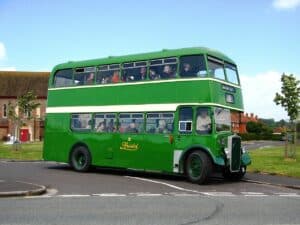
Bus from Bristol Omnibus - The 20th century brought a new era of transportation with the advent of motor buses. Recognising this, the company expanded its services to include motor buses in 1906 and subsequently changed its name to the Bristol Tramways and Carriage Company.
- By the 1920s, motor buses had overtaken trams in popularity, leading the company to cease its tram operations in 1941 and focus solely on bus services. Reflecting this shift, the company was rebranded as the Bristol Omnibus Company in 1957. Despite the challenges it faced, the Bristol Omnibus Company remained a vital part of the city's public transportation system for over a century, shaping and reflecting Bristol's social and economic evolution.
- However, the Bristol Omnibus Company was not without its controversies. During the 1960s, it was the centre of a significant racial equality dispute, known as the Bristol Bus Boycott. The company, reflecting the discriminatory employment practices prevalent in some sectors of British society, had an unwritten rule that people of colour were not employed as bus crew. This was a stance that was supported by the local branch of the Transport and General Workers' Union after it had passed a resolution in 1955 to ban 'coloured' people from working as bus conductors and drivers.
- This policy was not a covert secret, but an openly acknowledged practice. The company justified it by claiming that white passengers would be uncomfortable being served by bus crew of a different race. Non-white applicants, even those who were highly qualified and experienced, were routinely turned away under this racially biased policy. The company's discriminatory practice was not only a grave injustice to the immigrants seeking employment but also a contravention of the fundamental tenets of equality enshrined in British law.
- The discriminatory practices of the Bristol Omnibus Company were exposed in the public eye in 1963, largely due to investigative journalism by the Bristol Evening Post. The newspaper brought to light the company's racist employment policies, provoking public outrage and sparking an important dialogue about racial equality in Bristol and beyond.
- The Bristol Evening Post played a crucial role in raising awareness about the problem, highlighting individual stories and providing a platform for activists.
- Their coverage ultimately led to significant public pressure on the Bristol Omnibus Company to change its discriminatory employment practices.
West Indian Development Council
- The Bristol Omnibus Company's racially discriminatory practices were a catalyst for the Bristol Bus Boycott, a significant event in the UK civil rights movement. The company's openly racist policy of not hiring people of colour as bus crew incensed local communities, especially the Afro-Caribbean population, who were the main victims of this discriminatory practice.
- The boycott was spearheaded by a small group of activists, including Paul Stephenson, Roy Hackett, Owen Henry and Prince Brown. This group, known as the West Indian Development Council, was deeply committed to combating racial discrimination and fighting for equal rights. They decided to take a stand against the Bristol Omnibus Company's discriminatory hiring practices. The boycott was inspired by the American Civil Rights Movement, particularly the Montgomery Bus Boycott led by Rosa Parks and Dr Martin Luther King Jr.
- The council, recognising the need for decisive action, orchestrated a strategy to expose the Bristol Omnibus Company's bias.
- They selected a young man named Guy Bailey, who was excellently qualified and well-spoken, to apply for a job at the company. Bailey's job application was accepted over the phone, but when he arrived in person for his interview, the company rescinded the job offer upon realising that he was of Afro-Caribbean descent. This blatant act of discrimination was a stark demonstration of the company's prejudiced hiring policies, adding fuel to the growing public outcry and lending credibility to the claims made by the West Indian Development Council.
- In a bold move aimed at challenging the status quo, Stephenson called a press conference to bring the injustice of the Bristol Omnibus Company's discriminatory hiring practices to the public's attention. This press conference marked a critical turning point in the Bristol Bus Boycott.
- Stephenson, with his eloquent and impassioned speech, detailed the unapologetic discrimination faced by Guy Bailey, catching the attention of the media and the wider public. He highlighted the fact that Bailey, despite being well-qualified for the job, was denied the opportunity solely based on his race. Stephenson's articulate and incisive critique of the bus company's policy underscored the systemic racism entrenched in the society of the time, igniting a wave of support for the boycott.
- The press conference, with its broad coverage, stirred public opinion and increased pressure on the Bristol Omnibus Company. It was a pivotal moment that galvanised the fight against racial discrimination in Bristol and beyond.
The Boycott
- On 28 April 1963, the activists urged Bristol's West Indian community to stop using the city's buses until the company changed its discriminatory policies. The action was met with widespread support from the community, resulting in a significant drop in bus usage.
- Despite strong opposition, the Bristol Omnibus Company initially refused to change its discriminatory hiring policy. The boycott escalated, garnering national attention and putting immense pressure on the company. Media outlets across the country picked up the story, and the boycott became a national issue, prompting debate about racial discrimination in Britain.
- The boycott's impact extended far beyond the local community, resonating on a global scale and serving as a catalyst for change in civil rights policies worldwide. The event was closely watched by other nations grappling with their own civil rights issues, particularly those in the throes of decolonisation. It reinforced the importance of nonviolent resistance as a tool for achieving social and political change, echoing the principles espoused by global figures like Dr. Martin Luther King Jr. and Mahatma Gandhi.
- The boycott persisted for four long months, deeply impacting the company financially. Finally, on 28 August 1963, the Bristol Omnibus Company announced an official end to its racist employment policy. This victory was a significant milestone in the fight against racial discrimination in Britain.
Aftermath and Impact
- In the aftermath of the boycott, the impact of the Bristol Bus Boycott reverberated throughout Britain, causing a vital shift in public consciousness regarding racial discrimination. It brought the issue of racial inequality to the forefront of national discourse, laying the groundwork for the enactment of the Race Relations Act of 1965.
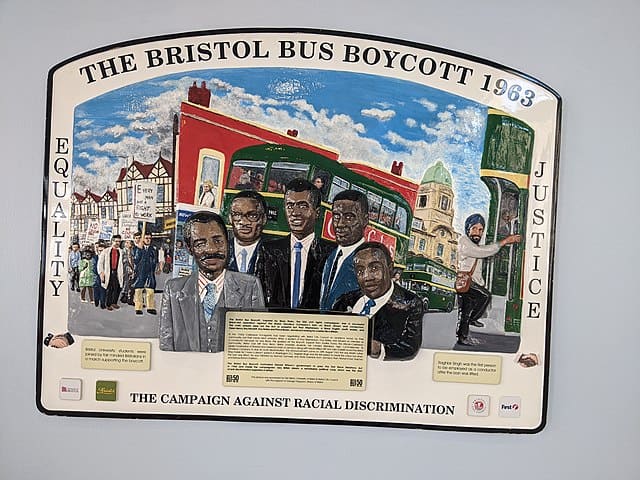
Bristol Bus Boycott Plaque - This act marked a significant step in British legislative history as it was the first piece of legislation in the UK to address racial discrimination. It made it a civil offence to refuse to serve a person, obstruct a person or put them at any disadvantage on the grounds of their race, colour, or ethnic or national origins in 'places of public resort', such as hotels, restaurants and pubs.
- Despite the groundbreaking precedence set by the Race Relations Act of 1965, the legislation had significant limitations that hindered its effectiveness in curbing racial discrimination.
- For one, its coverage was limited and did not extend to areas like employment, housing, and provision of goods and services, where discrimination was rampant. Furthermore, enforcement of the act was weak, with no specific body set up to implement it, and the penalties for violations were insufficient to deter discriminatory practices.
- These shortcomings of the 1965 act exposed the inadequacy of the legislative approach to address racial discrimination in all its dimensions.
- The resulting public outrage and demand for comprehensive anti-discrimination laws led to the passage of the Race Relations Act of 1968. This new act expanded the scope of anti-discrimination laws to cover employment and housing, among other areas. It also established the Race Relations Board and the Industrial Tribunal, responsible for handling complaints and enforcing the act, thereby addressing the enforcement weakness of its predecessor.
- The Bristol Bus Boycott also had far-reaching implications beyond the legislative changes. It served as a powerful model for nonviolent protest and civil disobedience, demonstrating the efficacy of peaceful resistance in the fight against racial inequality. This protest inspired subsequent movements, not only in the UK but also worldwide, leading to significant shifts in societal attitudes towards racial discrimination.
- Furthermore, the boycott propelled the issue of racial discrimination into mainstream media, fostering a greater understanding and awareness among the general public. This heightened consciousness prompted many businesses and institutions to revisit their policies, leading to a broader societal shift towards promoting diversity and inclusivity.
- The boycott also had a profound impact on the lives of the minority communities in Britain. It gave them a renewed sense of hope and empowerment, bolstering their belief in the power of collective action to bring about societal change. The Bristol Bus Boycott stands as a testament to the enduring power of unity and resilience in the face of injustice.
Image Sources
- https://upload.wikimedia.org/wikipedia/en/6/6f/Student_march_in_support_of_the_Bristol_Bus_boycott.jpg
- https://upload.wikimedia.org/wikipedia/commons/thumb/6/6d/Sea_Mills_Bristol_Omnibus_C8320_UHY360.jpg/1280px-Sea_Mills_Bristol_Omnibus_C8320_UHY360.jpg
- https://upload.wikimedia.org/wikipedia/commons/thumb/5/53/BristolBusBoycottPlaque.jpg/640px-BristolBusBoycottPlaque.jpg
Frequently Asked Questions
- What was the Bristol Bus Boycott?
The Bristol Bus Boycott was a significant civil rights protest in Bristol, England. It was inspired by the American Civil Rights Movement and aimed to end racial discrimination in the city's public transportation system.
- When did the Bristol Bus Boycott start and end?
The boycott began on 29 April 1963, when members of the West Indian Development Council (WIDC) called for a boycott of the company's buses. It officially ended on 28 August 1963, after the bus company agreed to end its discriminatory hiring practices.
- What were the outcomes of the Bristol Bus Boycott?
The boycott was successful in achieving its primary goal. The Bristol Omnibus Company agreed to end its discriminatory hiring practices, opening employment opportunities for Black and Asian bus crews.

